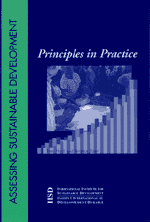The
Bellagio Principles for Assessment
Agenda 21 of the
1992 Earth Summit called for the development of new ways to measure and assess
progress toward sustainable development. In response, significant efforts
to assess performance have been made by corporations, non-government organizations,
academics, communities, nations, and international organizations.
In November
1996, an international group of measurement practitioners and
researchers from five continents came together at the Rockefeller
Foundationís Study and Conference Center in Bellagio, Italy to
review progress to date and to synthesize insights from practical
ongoing efforts. The attached principles resulted and were unanimously
endorsed.
| What is Their
Use and Who are the Users?
These
principles serve as guidelines for the whole of the assessment
process including the choice and design of indicators, their
interpretation and communication of the result. They are
interrelated and should be applied as a complete set. They
are intended for use in starting and improving assessment
activities of community groups, non-government organizations,
corporations, national governments, and international institutions.
 Full
Text Full
Text
|
 |
OVERVIEW
These principles
deal with four aspects of assessing progress toward sustainable
development. Principle 1 deals with the starting point of any assessment
- establishing a vision of sustainable development and clear goals
that provide a practical definition of that vision in terms that
are meaningful for the decision-making unit in question. Principles
2 through 5 deal with the content of any assessment and the need
to merge a sense of the overall system with a practical focus on
current priority issues. Principles 6 through 8 deal with key issues
of the process of assess-ment, while Principles 9 and 10 deal with
the necessity for establishing a continuing capacity for assessment.
1. GUIDING VISION
AND GOALS
Assessment of
progress toward sustainable development should:
- be guided
by a clear vision of sustainable development and goals that define
that vision
2. HOLISTIC PERSPECTIVE
Assessment of
progress toward sustainable development should:
- include
review of the whole system as well as its parts
- consider
the well-being of social, ecological, and economic sub-sys-tems,
their state as well as the direction and rate of change of that
state, of their component parts, and the interaction between parts
- consider
both positive and negative consequences of human activi-ty, in
a way that reflects the costs and benefits for human and eco-logical
systems, in monetary and non-monetary terms
3. ESSENTIAL ELEMENTS
Assessment of
progress toward sustainable development should:
- consider
equity and disparity within the current population and between
present and future generations, dealing with such concerns as
resource use, over-consumption and poverty, human rights, and
access to services, as appropriate
- consider
the ecological conditions on which life depends
- consider
economic development and other, non-market activities that contribute
to human/social well-being
4. ADEQUATE SCOPE
Assessment of
progress toward sustainable development should:
- adopt a
time horizon long enough to capture both human and ecosystem time
scales thus responding to needs of future genera-tions as well
as those current to short term decision-making
- define the
space of study large enough to include not only local but also
long distance impacts on people and ecosystems
- build on
historic and current conditions to anticipate future condi-tions
- where we want to go, where we could go
5. PRACTICAL FOCUS
Assessment of
progress toward sustainable development should be based on:
- an explicit
set of categories or an organizing framework that links vision
and goals to indicators and assessment criteria
- a limited
number of key issues for analysis
- a limited
number of indicators or indicator combinations to provide a clearer
signal of progress
- standardizing
measurement wherever possible to permit compari-son
- comparing
indicator values to targets, reference values, ranges, thresholds,
or direction of trends, as appropriate
6. OPENNESS
Assessment of
progress toward sustainable development should:
- make the
methods and data that are used accessible to all
- make explicit
all judgments, assumptions, and uncertainties in data and interpretations
7. EFFECTIVE COMMUNICATION
Assessment of
progress toward sustainable development should:
- be designed
to address the needs of the audience and set of users
- draw from
indicators and other tools that are stimulating and serve to engage
decision-makers
- aim, from
the outset, for simplicity in structure and use of clear and plain
language
8. BROAD PARTICIPATION
Assessment of
progress toward sustainable development should:
- obtain broad
representation of key grass-roots, professional, technical and
social groups, including youth, women, and indigenous people -
to ensure recognition of diverse and changing values
- ensure the
participation of decision-makers to secure a firm link to adopted
policies and resulting action
9. ONGOING ASSESSMENT
Assessment of
progress toward sustainable development should:
- develop
a capacity for repeated measurement to determine trends
- be iterative,
adaptive, and responsive to change and uncertainty because systems
are complex and change frequently
- adjust goals,
frameworks, and indicators as new insights are gained
- promote
development of collective learning and feedback to decision-making
10. INSTITUTIONAL CAPACITY
Continuity of
assessing progress toward sustainable development should be assured
by:
- clearly
assigning responsibility and providing ongoing support in the
decision-making process
- providing
institutional capacity for data collection, maintenance, and documentation
- supporting
development of local assessment capacity
|





